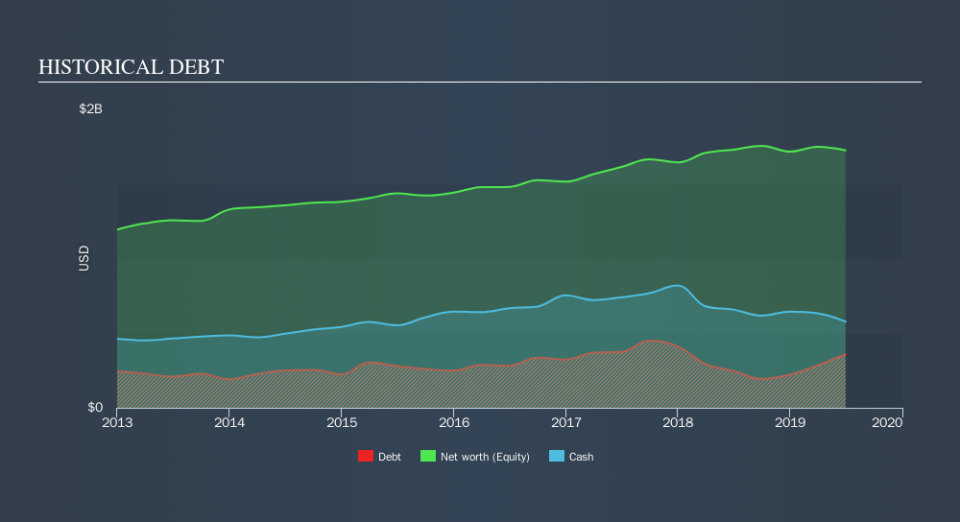Here's Why A. O. Smith (NYSE:AOS) Can Manage Its Debt Responsibly

Howard Marks put it nicely when he said that, rather than worrying about share price volatility, 'The possibility of permanent loss is the risk I worry about... and every practical investor I know worries about. So it might be obvious that you need to consider debt, when you think about how risky any given stock is, because too much debt can sink a company. We can see that A. O. Smith Corporation (NYSE:AOS) does use debt in its business. But the real question is whether this debt is making the company risky.
Why Does Debt Bring Risk?
Debt assists a business until the business has trouble paying it off, either with new capital or with free cash flow. Ultimately, if the company can't fulfill its legal obligations to repay debt, shareholders could walk away with nothing. While that is not too common, we often do see indebted companies permanently diluting shareholders because lenders force them to raise capital at a distressed price. Of course, debt can be an important tool in businesses, particularly capital heavy businesses. The first thing to do when considering how much debt a business uses is to look at its cash and debt together.
See our latest analysis for A. O. Smith
How Much Debt Does A. O. Smith Carry?
The image below, which you can click on for greater detail, shows that at June 2019 A. O. Smith had debt of US$358.6m, up from US$248.1m in one year. However, its balance sheet shows it holds US$577.8m in cash, so it actually has US$219.2m net cash.
How Strong Is A. O. Smith's Balance Sheet?
Zooming in on the latest balance sheet data, we can see that A. O. Smith had liabilities of US$730.6m due within 12 months and liabilities of US$719.9m due beyond that. Offsetting these obligations, it had cash of US$577.8m as well as receivables valued at US$634.8m due within 12 months. So it has liabilities totalling US$237.9m more than its cash and near-term receivables, combined.
Of course, A. O. Smith has a market capitalization of US$8.39b, so these liabilities are probably manageable. Having said that, it's clear that we should continue to monitor its balance sheet, lest it change for the worse. While it does have liabilities worth noting, A. O. Smith also has more cash than debt, so we're pretty confident it can manage its debt safely.
But the other side of the story is that A. O. Smith saw its EBIT decline by 4.9% over the last year. If earnings continue to decline at that rate the company may have increasing difficulty managing its debt load. The balance sheet is clearly the area to focus on when you are analysing debt. But ultimately the future profitability of the business will decide if A. O. Smith can strengthen its balance sheet over time. So if you want to see what the professionals think, you might find this free report on analyst profit forecasts to be interesting.
Finally, a business needs free cash flow to pay off debt; accounting profits just don't cut it. While A. O. Smith has net cash on its balance sheet, it's still worth taking a look at its ability to convert earnings before interest and tax (EBIT) to free cash flow, to help us understand how quickly it is building (or eroding) that cash balance. Over the most recent three years, A. O. Smith recorded free cash flow worth 61% of its EBIT, which is around normal, given free cash flow excludes interest and tax. This free cash flow puts the company in a good position to pay down debt, when appropriate.
Summing up
While it is always sensible to look at a company's total liabilities, it is very reassuring that A. O. Smith has US$219.2m in net cash. So we are not troubled with A. O. Smith's debt use. Of course, we wouldn't say no to the extra confidence that we'd gain if we knew that A. O. Smith insiders have been buying shares: if you're on the same wavelength, you can find out if insiders are buying by clicking this link.
If, after all that, you're more interested in a fast growing company with a rock-solid balance sheet, then check out our list of net cash growth stocks without delay.
We aim to bring you long-term focused research analysis driven by fundamental data. Note that our analysis may not factor in the latest price-sensitive company announcements or qualitative material.
If you spot an error that warrants correction, please contact the editor at editorial-team@simplywallst.com. This article by Simply Wall St is general in nature. It does not constitute a recommendation to buy or sell any stock, and does not take account of your objectives, or your financial situation. Simply Wall St has no position in the stocks mentioned. Thank you for reading.


